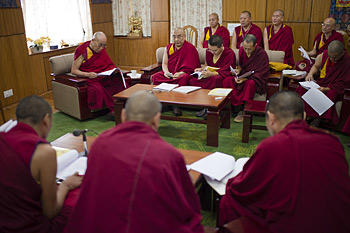 DHARAMSHALA: His Holiness the Dalai Lama’s interest in science is well-known. Conversations he began with modern scientists almost thirty years ago have spawned such thriving collaborations as the Mind & Life Institute a non-profit organization dedicated to building a scientific understanding of the mind to reduce suffering and promote well-being.
DHARAMSHALA: His Holiness the Dalai Lama’s interest in science is well-known. Conversations he began with modern scientists almost thirty years ago have spawned such thriving collaborations as the Mind & Life Institute a non-profit organization dedicated to building a scientific understanding of the mind to reduce suffering and promote well-being.
In recent years, scientific interest has grown in what ancient Indian thought, and Buddhist literature in particular, has to say about such phenomena as the mind and emotions for example. At the same time, His Holiness has begun to speak of a new way of thinking of the great body of literature translated largely from Indian sources into Tibetan, the more than 300 volumes of the Kangyur (translations of the Buddha’s words) and Tengyur (translations of commentaries by subsequent Buddhist masters). He has recommended classifying some content as Buddhist science, some as Buddhist philosophy and the remainder as concerned with spiritual practice. His view is that while interest in material dealing with spiritual practice might be limited to Buddhists, material related to Buddhist science and philosophy could have a much wider academic and intellectual appeal.
Over four days His Holiness and the group of eminent scholars from the Three Seats, engaged in lively discussions ranging from whether to include textual quotations from the Kangyur and Tengyur in the body of the text, or whether to consign them to end-notes, what emphasis to give to certain points in the presentation and the pros and cons of different technical terms. On the second and third days they were joined by Prof Samdhong Rinpoche who contributed his expert knowledge of Indian sources to the proceedings. Geshe Thutop, former abbot of Gyume Tantric College attended at His Holiness’s personal invitation, while teachers from Namgyal Monastery attended as observers.
Once a review of the science material was completed, an outline of the proposed book on Buddhist philosophy was also discussed.
His Holiness seeming well pleased by the progress made so far said:“We are talking about how to understand reality when we talk about the mind and its objects. Whatever goals we have, they are achieved by employing valid cognition. The mind has the potential to understand reality and this is a realistic presentation.”
